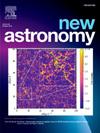通过四年观测对K2型双星V1393 Tau的综合研究
IF 1.9
4区 物理与天体物理
Q2 ASTRONOMY & ASTROPHYSICS
引用次数: 0
摘要
我们对双星V1393 Tau进行了低分辨率光谱、首次地基多色光曲线(LCs)分析和越轨系外行星巡天卫星(TESS)数据分析。我们确定其光谱类型为 K2V,并更新了其轨道周期为 0.24738715 天。通过威尔逊-德文尼程序,我们求解了十组光变曲线。通过BVRcIc波段LC2022.11,我们得到了质量比q=2.500(3)和填充因子f=11.73(6)%,这意味着V1393 Tau是一颗W型浅接触双星。我们通过建模光变曲线追踪了过去四年中光斑的迁移和演变过程。除LCS32外,光斑的大小交替变小或变大,其经度介于LCS70的λ=82.39∘和LC2022.10的102.56∘之间。本文章由计算机程序翻译,如有差异,请以英文原文为准。
A comprehensive study on the K2-type binary V1393 Tau in four-year observations
We carried out a low resolution spectrum, the first ground-based multi-color light curves (LCs) analysis, and Transiting Exoplanet Survey Satellite (TESS) data analysis for the binary V1393 Tau. We determined its spectral type of K2V and updated an orbital period 0.24738715 days. By the Wilson-Devinney program, we solved ten sets of light curves. From the BVRcIc-band , we obtained a mass ratio and a fill-out factor , which implies that V1393 Tau is a W-type shallow-contact binary. We traced the spot migration and evolution through modeling light curves during the past four years. The spot’s size alternately becomes smaller or bigger, and its longitude intervenes between in and in except for .
求助全文
通过发布文献求助,成功后即可免费获取论文全文。
去求助
来源期刊

New Astronomy
地学天文-天文与天体物理
CiteScore
4.00
自引率
10.00%
发文量
109
审稿时长
13.6 weeks
期刊介绍:
New Astronomy publishes articles in all fields of astronomy and astrophysics, with a particular focus on computational astronomy: mathematical and astronomy techniques and methodology, simulations, modelling and numerical results and computational techniques in instrumentation.
New Astronomy includes full length research articles and review articles. The journal covers solar, stellar, galactic and extragalactic astronomy and astrophysics. It reports on original research in all wavelength bands, ranging from radio to gamma-ray.
 求助内容:
求助内容: 应助结果提醒方式:
应助结果提醒方式:


